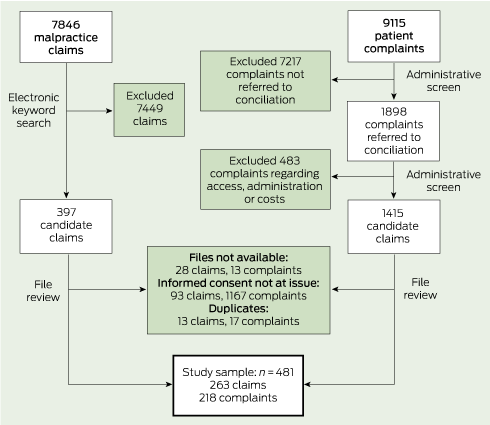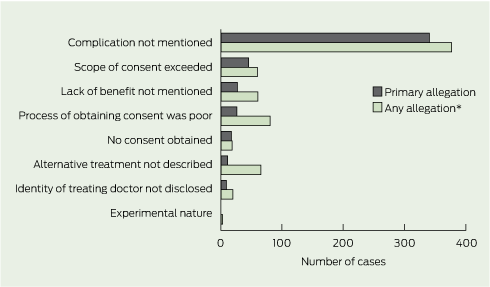A vast body of literature in ethics, law and medicine addresses informed consent — the process by which patients make decisions about participation in medical treatment and research through learning the benefits, risks and options.1 Most of this scholarship is normative.2 Although empirical research on the topic has grown in the last 20 years,3,4 there remains remarkably little empirical information on how the consent process actually functions (and malfunctions) in clinical practice.3,5
Avant Mutual Group Limited (Avant) and the Office of the Health Services Commissioner of Victoria (HSC) provided data for the study. Avant, through its wholly owned subsidiary Avant Insurance Limited, provides coverage to about 55% of registered medical practitioners in Australia. The HSC has statutory responsibility for receiving, investigating and resolving written complaints about providers made by the users of health care services in Victoria.
The human research ethics committee at the University of Melbourne approved the study.
We established definitions for claims, complaints and cases (Box 1). Our study definition of what constituted a dispute over informed consent (a “case”) was patient centred.8 We did not seek to evaluate the reasonableness or legitimacy of patients’ allegations, with one exception: if a patient alleged a failure to warn of the risks of an outcome that occurred, and there was strong clinical evidence in the case file that the outcome had not in fact occurred, we excluded the case.
From 7846 claims, we identified 397 candidate cases through searching for keywords (eg, informed, consent, warn, risks, explain, disclose) in free-text précis of the allegations (two to five sentences written by claim managers). We then examined the full claim file on each of these to determine whether it met our case definition (Box 2). About 20% of complaints received by the HSC cannot be resolved easily by the parties involved and are referred to a dispute resolution process. These “conciliated” complaints were our focus. After ruling out conciliated complaints in several categories (access, administration, cost) that were extremely unlikely to have involved consent issues, three physician reviewers examined the hard-copy files associated with the rest (1415) to determine which met our case definition (Box 2).
The data for this study came primarily from hard-copy files. The variables of interest were determined through a review of the informed consent literature and a pre-review of 20 claim files and 20 complaint files. We collected information on patient characteristics (sex, age); doctor characteristics (sex, age, trainee status, specialty); location of the incident (type of facility, clinical setting); the specific treatment involved in the episode of care; the patient’s allegations; and the case outcome.
Two medically qualified reviewers conducted the reviews onsite at Avant offices (Melbourne, Sydney and Brisbane) and the HSC (Melbourne) between March 2009 and January 2010. The reviewers underwent a day-long training session that covered the structure and content of claim and complaint files, use of the data collection instrument, and confidentiality.
To test the reliability of the review, a random subsample of cases consisting of about 10% (27) of the claims and 10% (23) of the complaints was re-reviewed by the second reviewer, who was blinded to the first review. We report κ scores9 for the primary allegation type and all allegation types because they are the only variables that required implicit judgements by the reviewers.
Our analyses are descriptive. Counts and percentages for the variables of interest generally did not differ between claims and complaints. We therefore reported results in aggregated form, except for variables with intrinsic differences in structure (eg, case outcomes).
We calculated the frequency of informed consent disputes by specialty using rates and rate ratios. Complaint rates are the total number of consent-related complaints over the study period, divided by the sum of annual counts of registered doctors in Victoria over the study period (“doctor-years”).10 Complaint rate ratios were calculated by dividing the complaint rate for each specialty by the complaint rate for a reference group (general practitioners). Differences between rate ratios for specialties were calculated using x2 tests.
All analyses were conducted using Stata SE, version 10.0 (Stata Corp, College Station, Tex, USA).
A total of 3.4% (263/7846) of medical negligence claims and 11.5% (218/1898) of conciliated complaints involved allegations of deficiencies in the consent process. This corresponds to rates of 1.3 claims per 1000 Avant member-years (95% CI, 1.2–1.5) and 1.9 complaints per 1000 registered Victorian doctor-years (95% CI, 1.7–2.2). In 65% of claims (95% CI, 59%–71%) and 54% of complaints (95% CI, 47%–61%), the consent allegation stood alongside other allegations about the quality of care rendered.
Sixty-nine per cent of cases involved female patients (Box 3). Three-quarters of the incidents that prompted cases occurred in privately owned health care facilities and nearly two-thirds occurred in consulting rooms.
More than half (57%) of the cases were against surgeons (Box 4). Four surgical subspecialties — plastic, general, orthopaedic and ophthalmic surgery — accounted for 81% of all cases against surgeons. Obstetrics–gynaecology (14%) and general practice (11%) were the other prevalent specialties. Collectively, surgeons, obstetrician-gynaecologists and GPs were involved in 82% of cases.
In 71% of cases, the primary allegation concerned a complication of treatment that had not been mentioned or fully understood, and then materialised (Box 5). The next most common types of primary allegations were that the scope of the consent had been exceeded (10% of cases), the risk that the procedure would confer no benefit (as opposed to harm) had not been mentioned (6%), and the process by which consent was obtained was unsatisfactory (6%). Process allegations involved situations in which patients felt rushed, pressured to proceed, or regarded the language used as incomprehensible. No case had as its primary allegation that there were problems with consent to experimental treatments or research protocols.
The disputes arose in relation to a wide array of treatments; however, clustering was evident. Thirty specific treatments accounted for 71% of cases (Box 6). There was a heavy orientation toward operations: 92% (442/481) of cases involved surgical procedures and 16% (77/481) involved cosmetic procedures. Five types of treatments — procedures involving reproductive organs (57/481; 12% of cases), procedures involving facial features excluding eyes (57/481; 12%), prescription medications (40/481; 8%), eye surgery (36/481; 7%) and breast surgery (32/481; 7%) — accounted for 46% of all cases.
The cases took an average of 1.8 years (interquartile range [IQR], 0.5–3.6 years) from filing to closure, with complaints (median, 1.0 years; IQR, 0.6–1.6 years) resolved more quickly than claims (median, 2.3 years; IQR, 1.3–3.5 years). Plaintiffs received payments in 51% (135/263) of claims. Eleven claims proceeded to court verdict, and plaintiffs won damages in three. Monetary restoration was paid to complainants in 27% (59/218) of complaints but, consistent with the functions of the HSC, a much wider range of remedies was sought and obtained in these and other complaints.
Of nearly 10 000 Australian medicolegal cases resolved in the 7 years 2002–2008, around one in 30 medical negligence claims and one in nine conciliated complaints included allegations of problems with informed consent. Five treatment types accounted for nearly half of all cases: reproductive, facial, medication, eye and breast. Ninety-two percent of cases involved surgical procedures and 16% involved cosmetic procedures. The heavy concentration of informed consent disputes around surgical procedures was also evident in other aspects of our findings. Plastic surgeons, orthopaedic surgeons, vascular surgeons, and dermatologists experienced disproportionately high rates of consent disputes. Moreover, about three-quarters of the cases centred on the allegation that certain complications, which ultimately affected the patient, were not mentioned or properly explained before the treatment. Thus, the concept of a “typical” informed consent dispute has real currency: it is an operation, often undertaken for cosmetic purposes, in which the patient alleges that a complication was not properly disclosed.
To the best of our knowledge, this is the first study to investigate in a real-world setting what happens when informed consent goes poorly from the patient’s perspective — poorly enough to prompt complaints or litigation. Unlike studies that have probed patients’ views on what they want or hope to be told before treatment,11,12 we profiled situations in which patients “voted with their feet” in proclaiming unmet expectations. Improved understanding of these situations helps to spotlight facets of care in which there is a gap between what doctors do and what patients want; it may also be instructive for clinicians who are eager to avoid the vicissitudes of medicolegal processes.
In our sample, the predominance of cases alleging undisclosed risks related to surgery is striking. High-profile court battles over informed consent in the United States,13 Australia,14 Malaysia,15 New Zealand,16 Ireland,17 and Canada18 have centred on precisely this scenario.19 Concerns about surgical risks not properly explained appear to be the heartland of contemporary disputes between patients and doctors over consent, at least in Australia. By contrast, other types of breakdowns in the consent process that have attracted intense scholarly attention and debate (eg, failure to canvass alternative treatments, patient competence) appear to be infrequent triggers of formal disputes, and still others (eg, consent to services rendered as part of research), however interesting from an ethical perspective, are exotic in medicolegal fora.
Our study has several limitations. First, we describe perceived problems with the consent process that spark claims and complaints against doctors and health care institutions, but our sample may be unrepresentative of broader quality problems in this area because they are refracted through the lens of patients’ claiming behaviour.6,20 Second, we were constrained by the information set available in claim and complaint files. Finally, we took cases at face value and did not seek to make objective determinations about their legitimacy, although whether this is a true limitation is questionable in light of the study objectives.
In setting legal standards for informed consent, courts in many countries14-18 have moved towards paying deference to what reasonable patients would want to know before choosing a treatment course. Our study sheds light on patient preferences in a legal context. Consistent with the quality improvement mantra that “every defect is a treasure,”21 further research into disputes over informed consent and other preventable breakdowns in care is warranted. It has dual potential to inform risk management strategies and to guide efforts to improve the way clinicians and patients communicate about treatment choices.
1 Definitions
Claim: a written demand for compensation.6,7
Case: a claim or complaint in which a patient (or patient representative) alleged that —
Received 30 March 2011, accepted 29 June 2011







Abstract
Objective: To describe the frequency, characteristics, and outcomes of medicolegal disputes over informed consent.
Design and setting: Retrospective review and analysis of negligence claims against doctors insured by Avant Mutual Group Limited and complaints lodged with the Office of the Health Services Commissioner of Victoria that alleged failures in the informed consent process and were adjudicated between 1 January 2002 and 31 December 2008.
Main outcome measures: Case frequency (by medical specialty), type of allegation, type of treatment.
Results: A total of 481 cases alleged deficiencies in the informed consent process (218 of 1898 conciliated complaints [11.5%]; 263 of 7846 negligence claims [3.4%]). 57% of these cases were against surgeons. Plastic surgeons experienced dispute rates that were more than twice those of any other specialty or subspecialty group. 92% of cases (442/481) involved surgical procedures and 16% (77/481) involved cosmetic procedures. The primary allegation in 71% of cases was that the clinician failed to mention or properly explain risks of complications. Five treatment types — procedures on reproductive organs (12% of cases), procedures on facial features excluding eyes (12%), prescription medications (8%), eye surgery (7%) and breast surgery (7%) — accounted for 46% of all cases.
Conclusions: The typical dispute over informed consent involves an operation, often cosmetic, and allegations that a particular complication was not properly disclosed. With Australian courts now looking to patient preferences in setting legal standards of care for risk disclosure, medicolegal disputes provide valuable insights for targeting both quality improvement efforts and risk management activities.